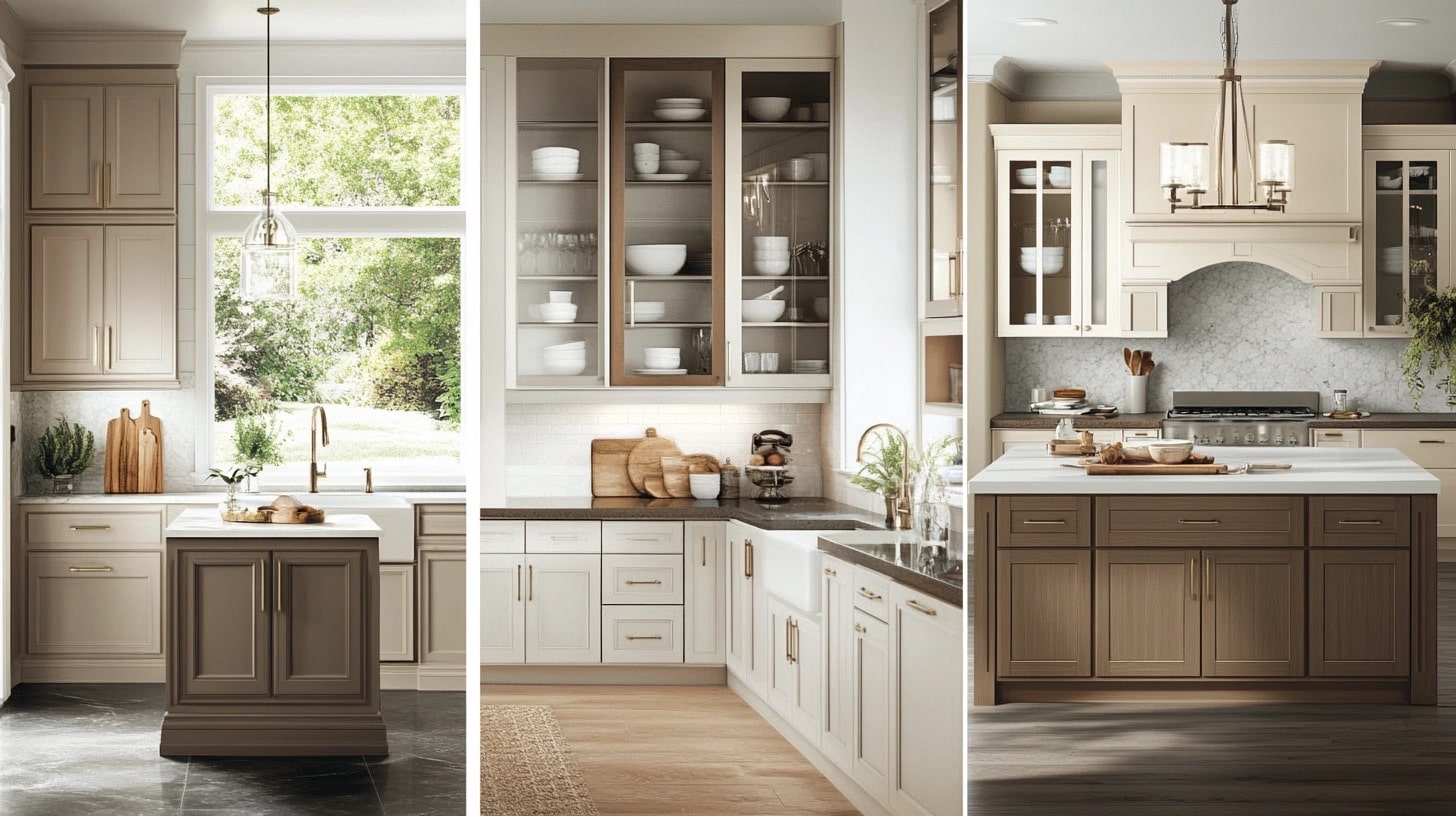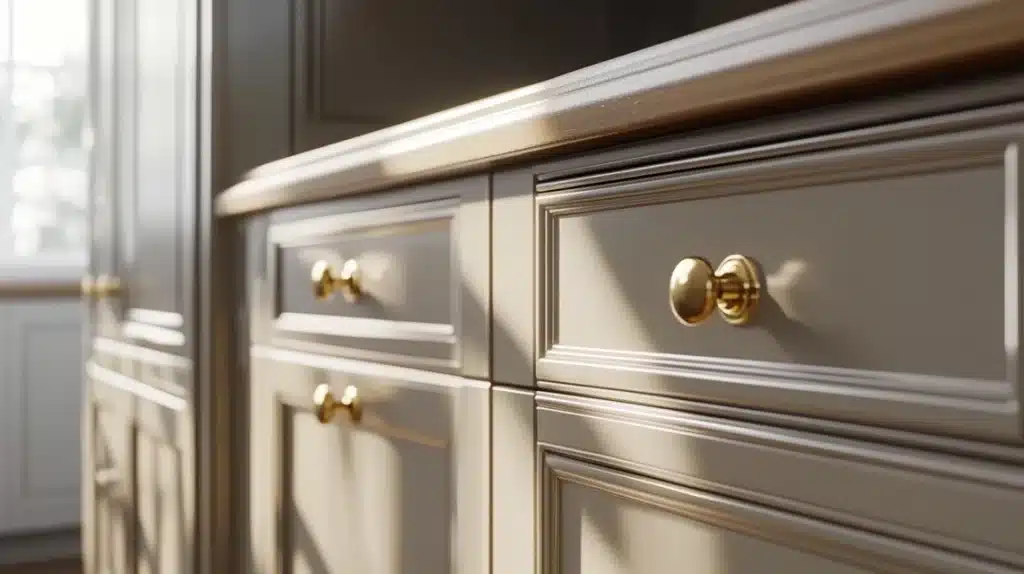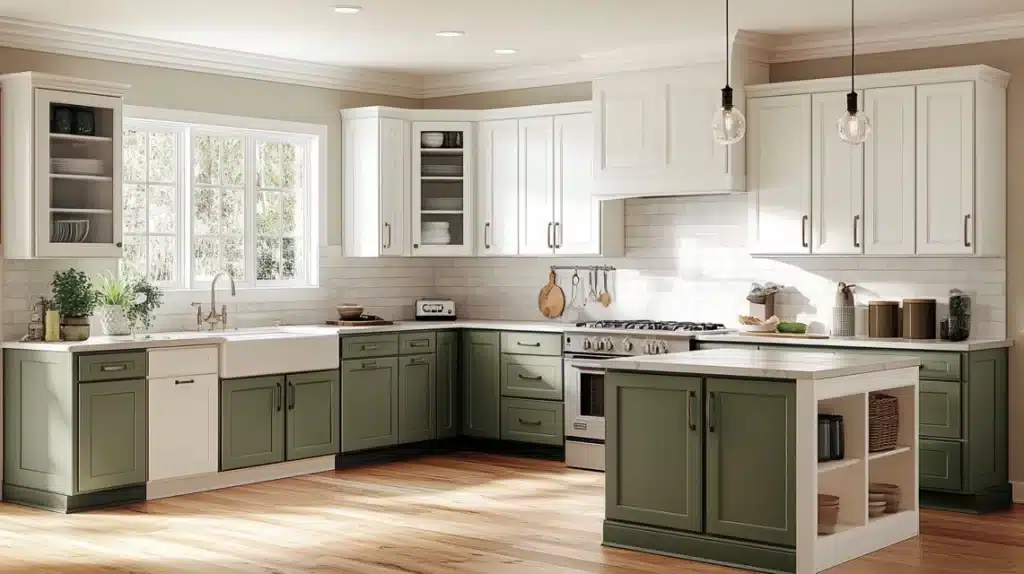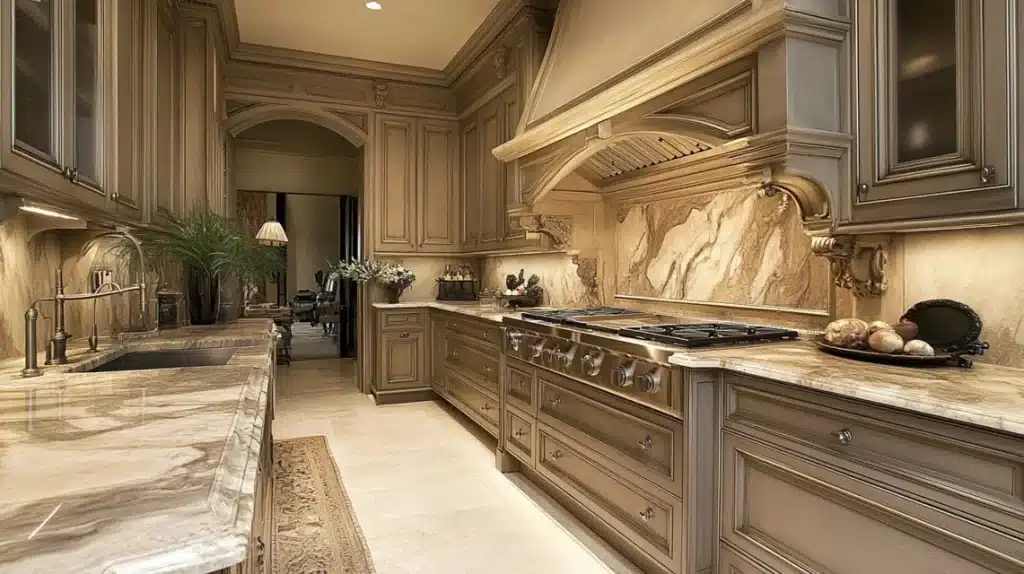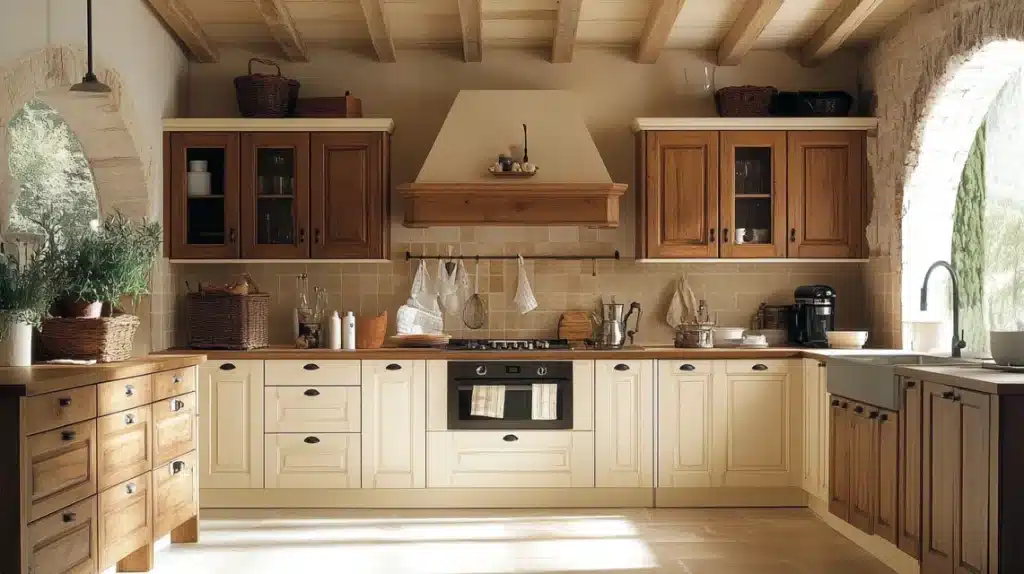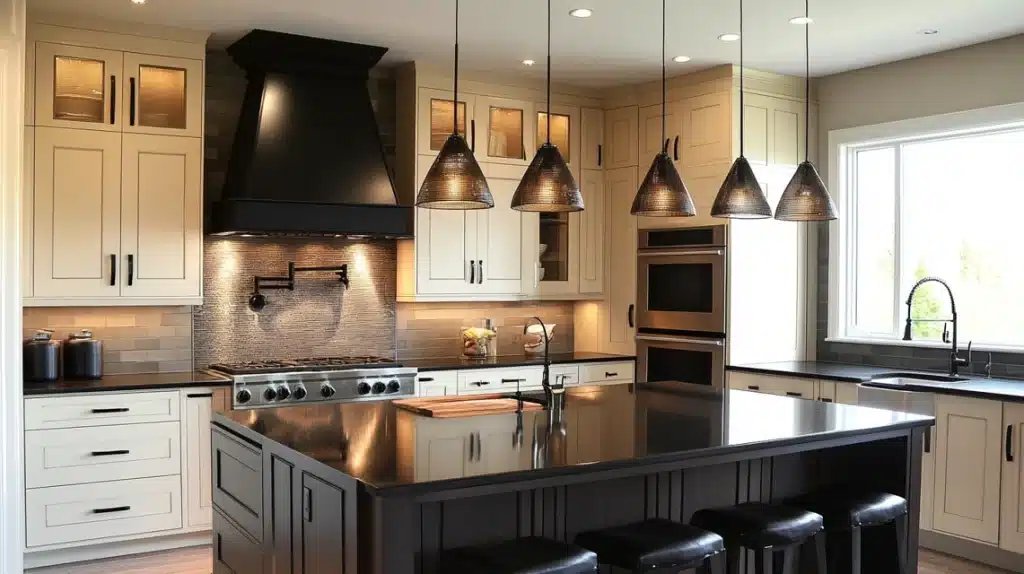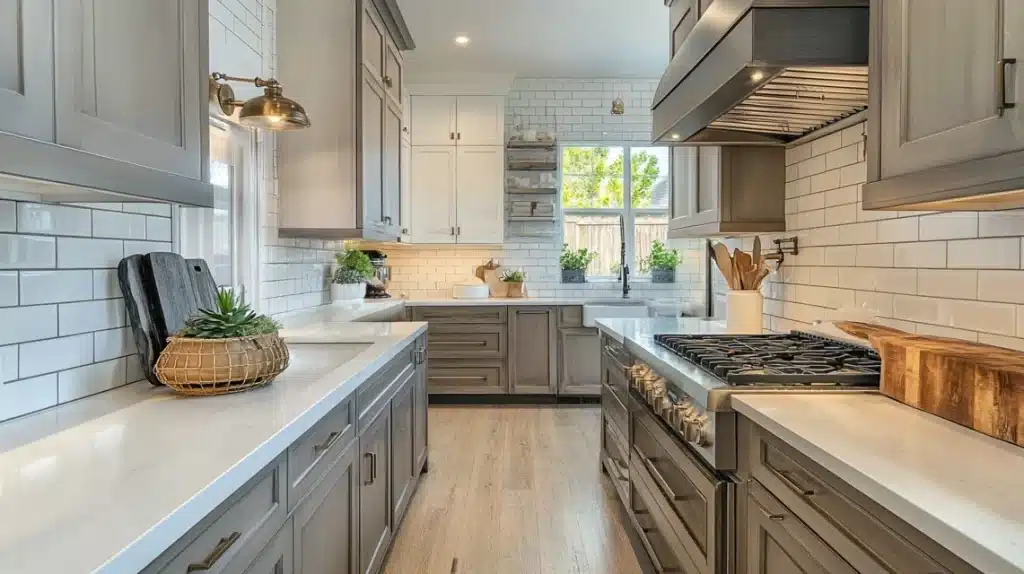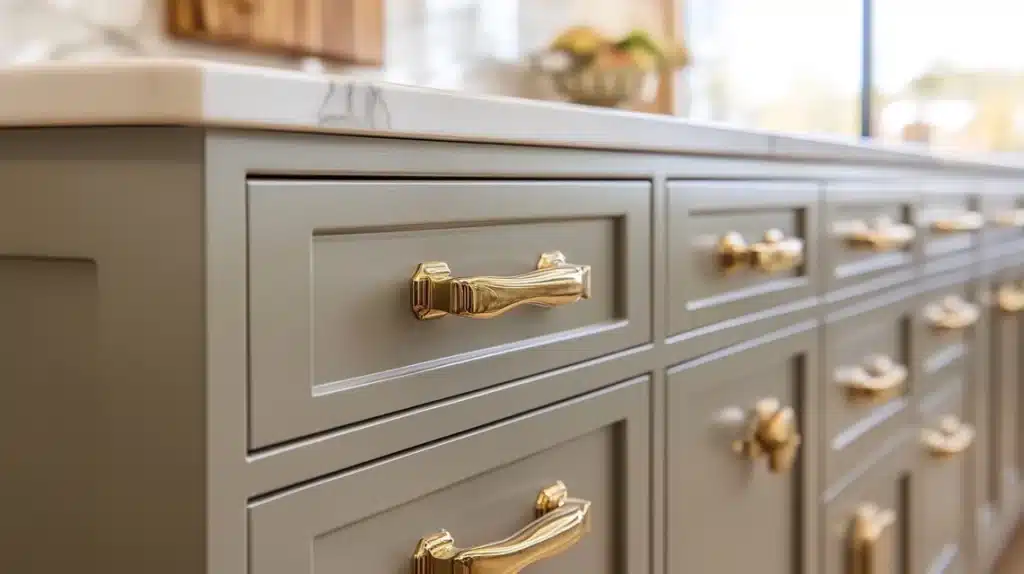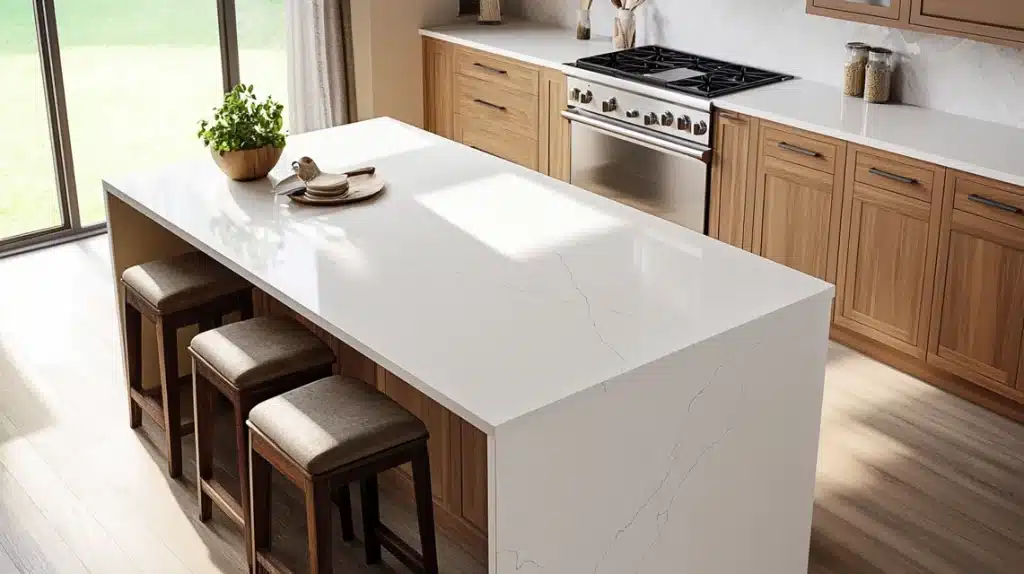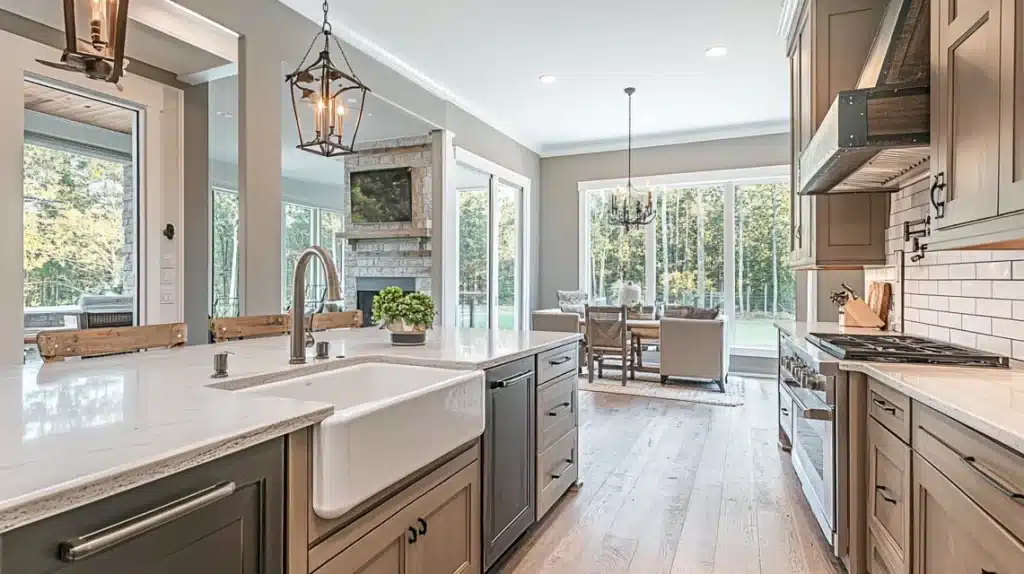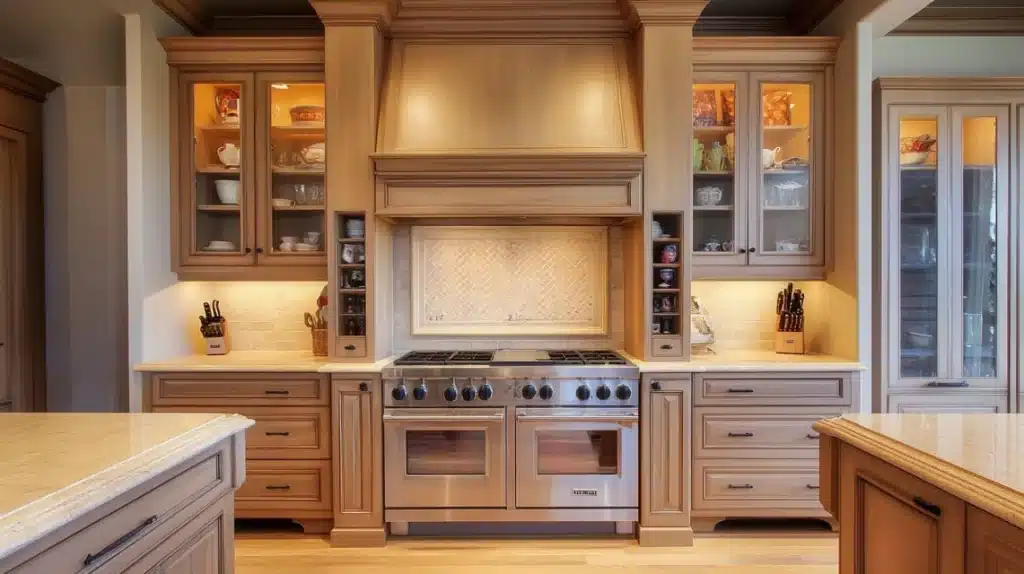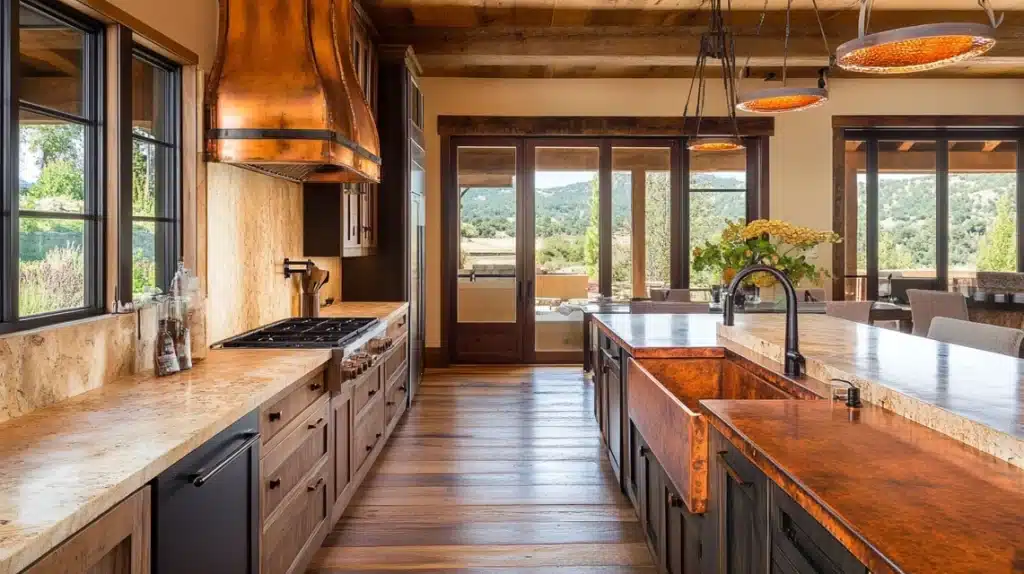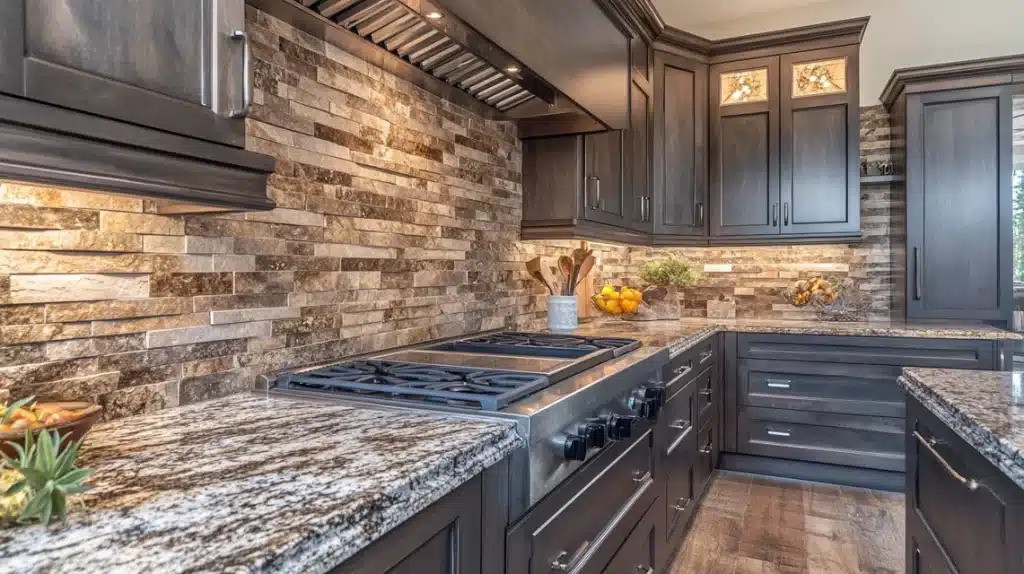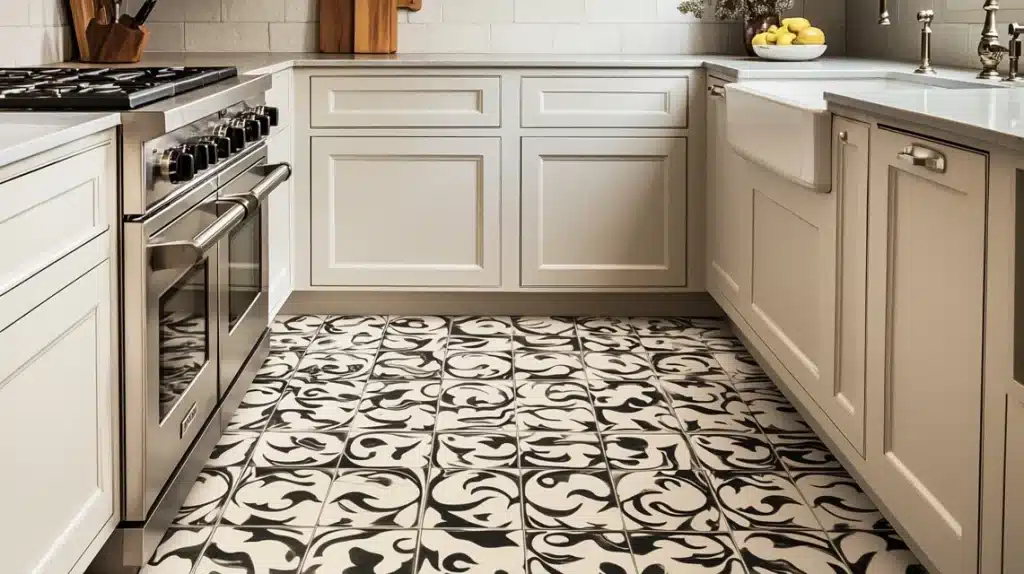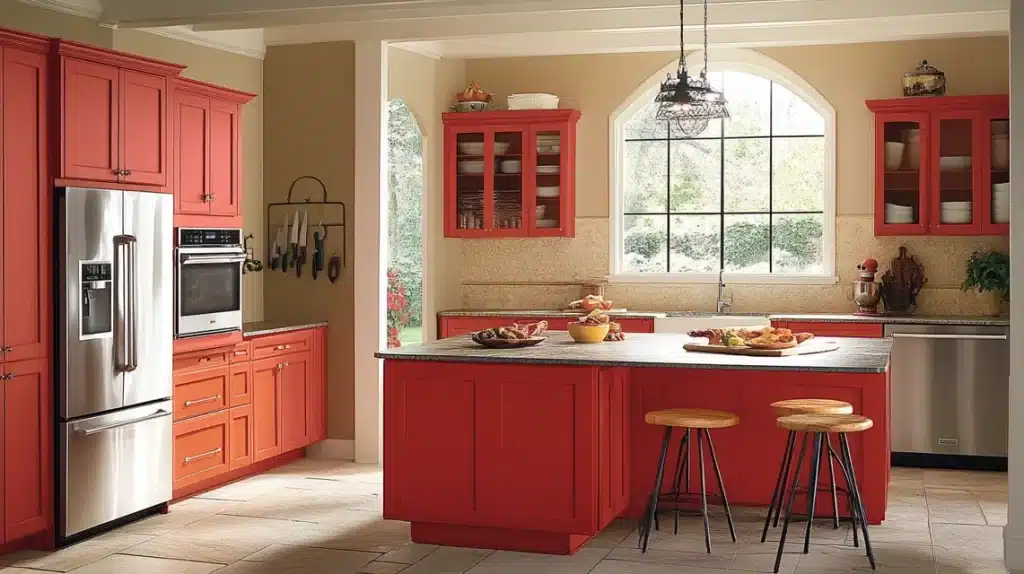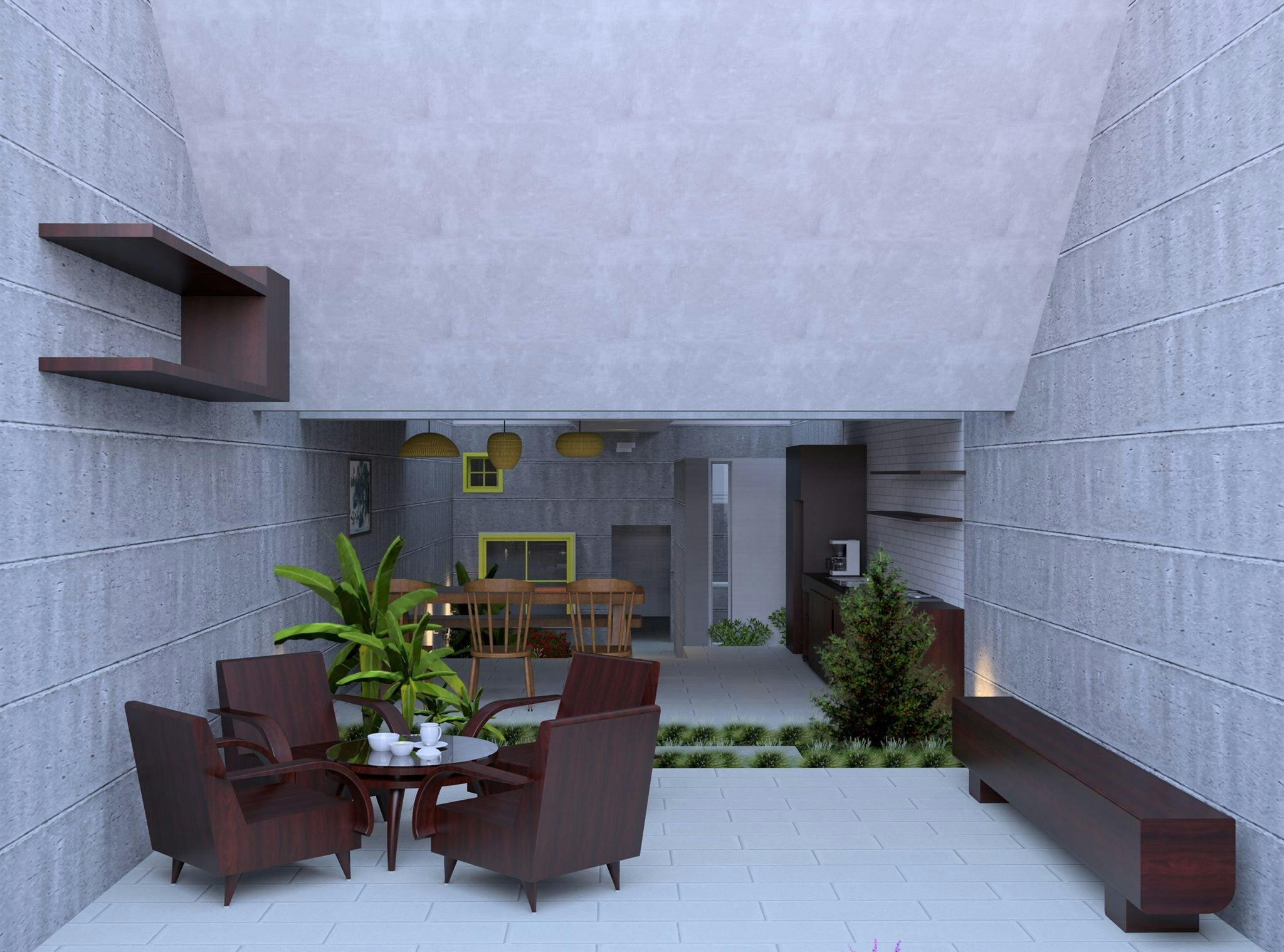Looking at my client’s dated oak cabinets last spring, I never imagined how dramatically a mushroom tone would change everything.
This perfect neutral – not quite gray or beige – brought instant sophistication to their space.
Mushroom cabinets possess a chameleon-like quality.
Morning light makes them appear warm and welcoming, the afternoon sun brings out subtle gray undertones, and evening lighting transforms them into rich, cozy backgrounds for family gatherings.
Through years of kitchen transformations, I’ve discovered that mushroom tones work magic in any space.
These twenty ideas showcase how versatile this color choice can be, whether you’re creating a modern masterpiece or updating a traditional space.
Creative Mushroom Kitchen Cabinets Ideas
1. Classic Brass and Mushroom Harmony
Transform standard cabinets into elegant focal points through careful color selection and hardware pairing.
The key lies in selecting the perfect mushroom shade – not too gray, not too beige – that changes subtly throughout the day.
Creating depth through varying light reflection requires the strategic placement of brass elements.
Adding aged brass hardware brings warmth while maintaining sophistication.
Consider how natural light plays with these elements throughout different times of day.
Complete DIY Guide
- Begin with thorough surface preparation, including degreasing, sanding, and cleaning all cabinet surfaces. Ensure proper ventilation and dust collection throughout the process.
- Create multiple test boards with different primer and paint combinations, allowing each to cure fully before making final color selections based on various lighting conditions.
- Develop a systematic approach to hardware installation by creating detailed templates, pre-drilling all holes, and testing placement with temporary mounts before final installation.
- Install a comprehensive drawer slide reinforcement system that accommodates the additional weight of brass hardware while ensuring smooth operation for years of use.
- Establish a detailed maintenance routine including specialized cleaning products for both painted surfaces and brass hardware, along with touch-up procedures for future needs.
2. Two-Tone Balance Creation
Transform your kitchen through strategic color placement that creates visual harmony between upper and lower cabinets.
Understanding how light travels through your kitchen helps determine which cabinets receive the mushroom tone treatment.
Creating perfect transitions between white uppers and mushroom lowers requires careful attention to joint lines.
Adding subtle connecting elements through hardware and trim pieces unifies the two-tone look.
Consider how countertop materials will bridge the color transition between upper and lower cabinets.
Complete DIY Guide
- Develop a comprehensive color transition plan including detailed drawings, material lists, and precise measurements while accounting for all trim pieces and end panels that connect the two finishes.
- Create sample boards using your exact cabinet material, testing various primer combinations and application techniques until achieving perfect adhesion for both white and mushroom tones.
- Establish a systematic painting approach starting with upper cabinets, allowing complete cure time before masking for lower cabinet painting to prevent any bleed between color zones.
- Install unified hardware that complements both finishes, ensuring perfect alignment through careful template creation and pre-drilling while maintaining consistent spacing throughout.
- Design and implement a protection system for both finishes, including specialized cleaning products, touch-up protocols, and seasonal maintenance schedules.
3. Marble and Mushroom Integration
Transform your kitchen by pairing luxurious marble countertops with sophisticated mushroom cabinets.
Creating perfect color harmony requires carefully selecting marble veining that complements your chosen mushroom tone.
Understanding how different lighting affects both surfaces ensures beautiful transitions throughout the day.
Proper sealing techniques protect both painted cabinets and marble surfaces from kitchen wear.
Consider how backsplash materials will connect these two main elements.
Complete DIY Guide
- Begin by completing a complete color analysis of your chosen marble. Then, create detailed paint match samples while considering both morning and evening lighting conditions.
- Establish a comprehensive surface preparation protocol, including proper sealing techniques for both cabinet surfaces and marble edges where they meet cabinet frames.
- Design and implement a custom trim solution where marble meets cabinet surfaces, ensuring proper expansion space while maintaining a seamless appearance.
- Create an integrated maintenance system that addresses both marble care and cabinet cleaning, including specialized products and seasonal deep cleaning procedures.
- Develop detailed documentation for future homeowners, including specific products, care instructions, and professional contact information for both surfaces.
4. Rustic Wood Enhancement
Transform your kitchen by combining mushroom cabinets with natural wood elements for warmth and character.
Creating a balance between painted surfaces and raw wood requires careful consideration of wood species and finish.
Understanding how wood tones will age ensures long-term color harmony with painted surfaces.
Adding proper sealing to both surfaces protects against kitchen moisture while maintaining aesthetic appeal.
Consider how metal hardware choices can bridge these two distinct materials.
Complete DIY Guide
- Begin with a thorough wood selection process, analyzing grain patterns and natural coloration while creating sample boards with various stain and seal combinations.
- Establish an integrated finishing schedule that allows proper cure time for both painted cabinets and wood elements, preventing any cross-contamination during the process.
- Create custom transition pieces where wood meets painted surfaces, ensuring proper expansion allowances while maintaining a cohesive appearance throughout seasonal changes.
- Design and implement a specialized cleaning protocol that addresses both painted and wood surfaces, including humidity monitoring and seasonal maintenance requirements.
- Develop a long-term care plan including touch-up procedures for both finishes, wood conditioning schedules, and detailed documentation for future reference.
5. Minimalist Matte Excellence
Transform your kitchen with perfectly executed matte mushroom finishes that resist fingerprints and maintain their depth.
Creating flawless matte surfaces requires multiple thin coats with proper curing time between applications.
Understanding how light reflects differently off matte surfaces influences hardware and countertop choices.
Adding strategic lighting ensures the matte finish maintains its sophisticated appearance throughout the day.
Consider how cleaning and maintenance routines will preserve the matte finish long-term.
Complete DIY Guide
- Begin with extensive surface preparation, including high-grit sanding progression and thorough dust extraction, focusing on achieving a perfectly smooth base for the matte finish.
- Create a detailed application schedule allowing proper ventilation and cure time between coats while maintaining consistent temperature and humidity throughout the process.
- Design and implement a custom lighting plan that enhances the matte finish while minimizing glare spots and shadows that could detract from the minimalist aesthetic.
- Develop specialized cleaning protocols using products specifically formulated for matte finishes, including detailed instructions for handling common kitchen stains.
- Establish a comprehensive maintenance program, including touch-up procedures, annual deep cleaning schedules, and proper care documentation.
6. Shaker Style Sophistication
Transform traditional shaker cabinets with mushroom tones that enhance their classic lines and proportions.
Creating perfect paint coverage around shaker details requires careful preparation and specialized brushing techniques.
Understanding how light plays across raised panels influences color selection and finish choices.
Adding appropriate hardware emphasizes shaker simplicity while providing modern functionality.
Consider how trim and molding choices will complement the shaker style.
Complete DIY Guide
- Establish a meticulous surface preparation routine focusing on properly cleaning all panel edges and corners while ensuring consistent sanding across all raised surfaces.
- Develop custom application techniques that maintain proper paint thickness around all shaker details, preventing pooling or thin spots that could compromise the finish.
- Create a systematic hardware installation approach that respects traditional shaker placement while accommodating modern functional needs.
- Design specific cleaning protocols for reaching into panel corners and edges, including specialized tools and techniques for maintaining a consistent appearance.
- Build a comprehensive care package, including detailed grain touch-up procedures and seasonal maintenance schedules.
7. Black Accent Integration
Transform mushroom cabinets with carefully placed black elements that create dramatic contrast without overwhelming the space.
Creating the perfect balance between soft mushroom tones and bold black accents requires strategic placement.
Understanding how black hardware and fixtures interact with cabinet surfaces ensures cohesive design.
Adding black elements in varying sizes and finishes provides depth while maintaining harmony.
Consider how lighting will affect the contrast between finishes throughout the day.
Complete DIY Guide
- Begin with a detailed accent placement plan identifying key areas for black elements while maintaining visual balance throughout the space.
- Create multiple mockups testing different black finish options against your chosen mushroom tone, including matte, satin, and gloss variations.
- Establish proper installation techniques for various black elements, including hardware, light fixtures, and appliances, while ensuring consistent spacing and alignment.
- Develop specific cleaning protocols for different black finishes, preventing water spots and fingerprints while maintaining the dramatic contrast.
- Design long-term maintenance schedules, including touch-up procedures for both mushroom and black surfaces.
8. Green Harmony Creation
Transform your kitchen with a sophisticated blend of mushroom and green tones that bring nature indoors.
Creating perfect color balance requires a careful selection of complementary green shades that enhance mushroom tones.
Understanding how these colors interact in different lights ensures beautiful transitions throughout the day.
Adding natural elements bridges the color palette while reinforcing the organic theme.
Consider how metallic accents can enhance both colors simultaneously.
Complete DIY Guide
- Begin with extensive color testing in your specific light conditions, creating large sample boards demonstrating how both colors interact throughout the day.
- Establish clear boundaries between color transitions, including specialized taping and masking techniques to ensure crisp lines between finishes.
- Design unified hardware solutions that complement both colors while creating visual connections throughout the space.
- Develop custom cleaning solutions specific to each finish type, preventing cross-contamination while maintaining a consistent appearance.
- Create detailed documentation, including paint formulas, finishing techniques, and maintenance schedules for both colors.
9. Glossy Finish Enhancement
A high-gloss finish transforms ordinary mushroom cabinets into sophisticated reflective surfaces.
Light bounces differently across these gleaming surfaces, creating depth and movement throughout the day.
The key to perfect glossy cabinets lies in meticulous surface preparation and dust-free environments.
Professional-grade spraying techniques ensure streak-free finishes that last for years.
Maintenance becomes crucial with glossy surfaces, requiring specific cleaning protocols to maintain their mirror-like finish.
Complete DIY Guide
- Begin preparation in a controlled environment with advanced air filtration systems and proper ventilation to achieve a flawless glossy surface.
- Establish multiple stages of progressive sanding and priming, allowing proper cure time between each step while maintaining dust-free conditions.
- Create systematic spraying patterns using HVLP equipment with appropriate tip sizes and pressure settings for optimal gloss development.
- Develop specialized cleaning and maintenance protocols, including microfiber-only materials and specific product recommendations for long-term care.
- Design proper handling procedures during installation to prevent fingerprints and scratches while establishing protection methods for adjacent surfaces.
10. Subway Tile Integration
Your mushroom cabinets deserve the perfect backdrop – crisp white subway tiles provide exactly that contrast.
While traditional horizontal layouts work beautifully, consider unexpected patterns that add visual interest.
The transition between tile and cabinet requires precise planning and execution for professional results.
Proper grout color selection can dramatically impact the overall aesthetic connection between surfaces.
A modern interpretation of classic subway tiles opens endless possibilities for unique installations.
Complete DIY Guide
- Start with comprehensive wall preparation, which includes proper substrate installation and waterproofing measures.
- Create detailed tile layout plans accounting for optical centerlines and ensuring balanced cuts around all cabinet edges and corners.
- Establish proper spacing and support systems where tiles meet cabinet surfaces, allowing for natural movement while maintaining clean lines.
- Design specialized cleaning protocols for both tile and grout maintenance that won’t affect cabinet finishes.
- Implement long-term care procedures, including sealing schedules and detailed documentation for future maintenance.
11. Open Shelf Balance
Natural light floods differently through open shelving, creating dynamic shadows against mushroom cabinet bases.
The secret lies in perfectly proportioned shelf spacing that complements your cabinet heights.
Open spaces breathe fresh energy into the kitchen, while mushroom cabinets provide grounding elements below.
Throughout the day, sunlight plays across displayed items, casting ever-changing patterns on cabinet surfaces.
Thoughtful arrangement of decorative pieces maintains a visual balance between open and closed storage.
Complete DIY Guide
- Begin with structural analysis to determine proper support systems and load-bearing requirements for various shelf configurations.
- Design an integrated lighting plan accommodating both ambient and task lighting needs while highlighting displayed items.
- Establish proper mounting techniques using concealed brackets and reinforced attachment points for maximum stability.
- Create detailed organization systems, including rotation schedules for displayed items and specialized cleaning protocols.
- Develop maintenance procedures addressing both open shelving and cabinet surfaces while maintaining a cohesive appearance.
12. Gold Hardware Elevation
Warm metallic accents dance against cool mushroom tones, creating sophisticated contrast throughout your kitchen.
Each carefully chosen gold piece must complement rather than compete with the cabinet’s subtle coloring.
Between cabinet faces, strategically placed pulls create rhythm and movement across the space.
Morning light catches each metallic surface differently, bringing your kitchen to life as the sun rises.
Regular polishing maintains the perfect balance between aged charm and pristine shine.
Complete DIY Guide
- Create precise template systems ensuring perfect hardware alignment across all cabinet faces and drawers.
- Establish proper installation procedures, including pre-drilling techniques and protective measures for cabinet surfaces.
- Design specialized cleaning protocols for various metal finishes while protecting surrounding cabinet surfaces.
- Develop long-term care procedures, including tarnish prevention and periodic maintenance schedules.
- Build touch-up kits for both hardware and cabinet surfaces with detailed application instructions.
13. Quartz Surface Integration
Brilliant white quartz creates a stunning contrast against the earthy mushroom tones below.
Every joint and seam requires perfect alignment to maintain the countertop’s sleek appearance.
Below the surface, cabinet construction must support substantial quartz weight without compromise.
Light reflection between surfaces creates a subtle interplay throughout your kitchen space.
Precision in measurement ensures flawless integration of sink and appliance cutouts.
Complete DIY Guide
- Begin with a comprehensive cabinet assessment to ensure proper support structure for quartz weight loads.
- Create detailed templates accounting for all cutouts and edge treatments while maintaining proper overhangs.
- Establish specialized installation procedures, including proper adhesive selection and support placement during curing.
- Design integrated maintenance systems addressing both quartz and cabinet care without cross-contamination.
- Develop long-term protection protocols, including heat protection and stain prevention measures.
14. Farmhouse Sink Addition
Deep white porcelain makes a bold statement against the faces of the surrounding mushroom cabinet.
Supporting structures hidden within cabinet bases provide crucial stability for heavy sink loads.
Around the sink, carefully crafted trim pieces create seamless transitions between elements.
Water resistance becomes crucial when cabinet surfaces meet frequent splashing zones.
Every detail of installation must account for future access and maintenance needs.
Complete DIY Guide
- Start with structural modifications ensuring proper support for sink weight while maintaining cabinet integrity.
- Create custom water-resistant barriers protecting cabinet surfaces in splash-prone areas near sink edges.
- Establish proper drainage slopes and sealing systems to prevent moisture penetration into the cabinet structure.
- Design specialized cleaning protocols addressing both sink and cabinet maintenance requirements.
- Develop comprehensive care instructions, including seasonal maintenance schedules and emergency protocols.
15. Glass Front Display
Behind crystal-clear glass panels, mushroom tones create perfect backdrops for displayed items.
Interior lighting transforms ordinary cabinets into dramatic display cases as evening falls.
Each glass panel requires precise installation to maintain proper alignment and easy operation.
Between sections, careful trim work ensures seamless transitions from solid to glass fronts.
Professional-grade hinges support heavy glass while allowing smooth, silent operation.
Complete DIY Guide
- Begin with comprehensive planning for integrated lighting systems, including wiring paths and switch placement.
- Design custom glass panel specifications for proper thickness and safety requirements while maintaining visual aesthetics.
- Create specialized installation procedures, including precise hinge placement and door alignment techniques.
- Develop cleaning protocols for interior and exterior glass surfaces while protecting cabinet finishes.
- Establish long-term maintenance schedules, including hinge adjustments and lighting system updates.
16. Copper Accent Integration
Gleaming copper elements add warmth against cool mushroom backgrounds throughout the space.
Beneath cabinet surfaces, hidden support systems accommodate heavier copper sinks and fixtures.
Natural patina development requires careful consideration in material selection and placement.
Through seasonal changes, copper elements age gracefully while maintaining their striking appearance.
Strategic placement ensures copper accents enhance rather than overwhelm the overall design.
Complete DIY Guide
- Start with detailed placement planning that considers natural patina development and maintenance access requirements.
- Establish proper support systems for heavy copper elements while maintaining cabinet structural integrity.
- Create specialized cleaning and maintenance procedures preserving desired patina levels on copper surfaces.
- Design protection systems are preventing water damage where copper fixtures meet cabinet surfaces.
- Develop long-term care instructions, including patina management and seasonal maintenance requirements.
17. Stone Backsplash Harmony
Raw stone textures create a dramatic contrast against smooth mushroom cabinet faces.
Throughout the installation, careful color matching ensures stone selections complement cabinet tones perfectly.
Behind each stone piece, proper water barriers protect underlying cabinet structures.
Natural variations in stone coloring add depth and interest to the overall design.
Precise grout color selection ties together varying elements seamlessly.
Complete DIY Guide
- Begin with a comprehensive waterproofing system installation that protects cabinet structures from moisture penetration.
- Create detailed stone layout plans accounting for natural variations while maintaining visual balance throughout the space.
- Establish proper support and attachment systems, ensuring the long-term stability of heavy stone materials.
- Design specialized cleaning protocols addressing both stone and cabinet surfaces without cross-contamination.
- Develop maintenance schedules, including sealing requirements and detailed care instructions.
18. Vintage Pattern Enhancement
Bold floor patterns anchor mushroom cabinets while adding personality to the space.
Between modern and vintage elements, careful material selection creates the perfect balance.
Throughout the room, repeating motifs tie together various design elements seamlessly.
Strategic color choices in patterns complement rather than compete with cabinet tones.
Durable finishes ensure pattern integrity despite heavy kitchen traffic.
Complete DIY Guide
- Start with thorough subfloor preparation, ensuring proper support for decorative tile installation.
- Create precise layout plans centering patterns while maintaining proper flow around cabinet bases.
- Establish proper grout selection and application techniques protecting both tile and cabinet surfaces.
- Design specialized cleaning protocols addressing various pattern materials without damaging cabinet finishes.
- Develop long-term maintenance procedures, including grout care and pattern preservation techniques.
19. Exposed Beam Coordination
Rustic ceiling beams draw the eye upward while echoing mushroom cabinet tones below.
Each beam requires careful color selection to complement rather than match cabinet finishes exactly.
Proper beam spacing creates rhythm and architectural interest within the kitchen’s vertical space.
Natural wood grain patterns add organic texture while maintaining the room’s sophisticated feel.
Lighting placement between beams dramatically affects how cabinet colors read throughout the day.
Complete DIY Guide
- Begin with structural assessment, ensuring proper beam support while maintaining original ceiling integrity.
- Establish precise color-matching procedures accounting for wood grain variations and natural aging processes.
- Design integrated lighting systems between beams, effectively highlighting ceiling and cabinet features.
- Create specialized maintenance procedures addressing overhead beams and cabinet surfaces, including dust control measures.
- Develop long-term care instructions considering seasonal wood movement and finish touch-up requirements.
20. Color Pop Integration
Against neutral mushroom backgrounds, carefully chosen accent colors create stunning focal points.
Small appliances in bold hues add personality without overwhelming the space’s sophisticated feel.
Strategic color placement guides the eye throughout the kitchen while maintaining visual harmony.
Removable elements allow seasonal color updates while preserving the timeless cabinet base.
A proper balance between neutral and bold ensures lasting appeal through changing trends.
Complete DIY Guide
- Start with comprehensive color planning, identifying specific accent placement zones while maintaining visual balance.
- Create detailed documentation of accent color formulas and finishes, allowing for consistent future updates.
- Establish proper protection measures preventing bold accent colors from affecting cabinet surfaces during cleaning.
- Design flexible storage solutions accommodating changing accent pieces while protecting cabinet interiors.
- Develop coordinated cleaning protocols addressing neutral and bold surfaces while maintaining color integrity.
Benefits of Choosing Mushroom Cabinets
1. Why Time Loves Mushroom
While bright whites fade and dark woods date themselves, mushroom cabinets tell a different story.
These subtle neutrals maintain their sophisticated appeal through changing trends and passing seasons.
Inside my client’s ten-year-old kitchen, mushroom cabinets look as current today as when they were first installed.
Every design era welcomes these adaptable tones. From mid-century modern to contemporary farmhouse, mushroom shades effortlessly bridge style transitions.
Their subtle depth provides staying power that trendy colors can’t match.
Most importantly, mushroom tones develop character over time. Like fine leather or aged wood, they absorb the warmth of family gatherings and daily life.
2. The Shape-Shifter of Kitchen Design
Mushroom cabinets perform design magic in any setting.
Modern kitchens provide a sophisticated backdrop for sleek appliances and minimal hardware.
Traditional spaces welcome their subtle depth alongside carved moldings and vintage fixtures.
Watch how mushroom tones transform under different hardware choices. Brass brings out their warmth.
Chrome highlights cool undertones. Bronze emphasizes their earthiness. This adaptability makes future style updates simple and cost-effective.
These versatile cabinets welcome any countertop choice. They ground dramatic marbles, complement warm butcher block, and enhance cool quartz equally well.
3. Creating Comfort Through Color
Walking into a mushroom-toned kitchen feels like receiving a warm hug. These nurturing neutrals create instant comfort while maintaining sophistication.
Their subtle depth adds richness without overwhelming the senses.
Science supports this emotional response. Earthy mid-tones, like mushrooms, reduce stress and promote feelings of groundedness.
They remind us of natural elements while providing clean sophistication.
In evening light, mushroom tones create perfect ambiance for family dinners. During bright mornings, they offer gentle welcome without harsh reflection.
This psychological comfort makes kitchens more than cooking spaces – they become family havens.
Final Thoughts
After exploring these twenty transformations, one thing becomes crystal clear – mushroom cabinets offer endless possibilities.
Your kitchen deserves more than basic white or standard wood tones. It needs a more beautiful color as sunlight shifts throughout the day.
Remember that successful transformations start with proper planning. Consider your lighting, both natural and artificial. Think about your accent colors. Plan your hardware choices carefully.
Most importantly, take your time selecting your perfect mushroom shade. Test samples at different times of day.
Live with them for a while. The right tone will instantly feel right in your space.
Whether you’re planning a complete renovation or a simple cabinet refresh, mushroom tones offer the perfect balance of modern sophistication and timeless appeal.
They’re not just another neutral—they’re your kitchen’s new best friend.
Frequently Asked Questions
What Color Goes with Mushroom Kitchen Cabinets?
Mushroom cabinets welcome nearly any accent color. White quartz or marble countertops create a crisp contrast.
Warm metallics like brass or copper enhance natural undertones. Black hardware offers a sophisticated pop.
For backsplashes, consider soft whites, pale greens, or natural stone.
Remember that mushrooms act as chameleons, adapting beautifully to most color schemes.
What Colors Go Well with Mushroom Color?
Beyond kitchen elements, mushrooms pair naturally with sage green, navy blue, soft cream, and warm whites.
Earthy reds add dramatic accent points, and pale blues create serene combinations.
Think of mushrooms as nature’s neutral—they play well with any color you might find in a forest setting.
Even bold colors like deep teal or burgundy find perfect balance against mushroom backgrounds.
Is Mushroom Gray or Beige?
Mushrooms live between these two color families, which explains their versatility.
While some mushroom tones lean warmer toward beige, others pull cooler toward gray.
The magic lies in finding your perfect balance point. Watch how samples shift between gray and beige as light changes throughout the day.
The best mushroom shade maintains beautiful undertones in any light.
Is Mushroom a Cool or Warm Color?
Mushrooms’ beauty comes from their perfect temperature balance.
Most mushroom tones offer both cool and warm undertones, shifting with light and surrounding colors.
Morning light might emphasize warm notes, while evening shadows bring out cooler aspects.
This temperature flexibility explains why mushrooms work in both modern and traditional spaces, adapting to your desired mood.
How Do I Choose the Right Mushroom Shade for My Kitchen?
Start by examining your kitchen’s natural light patterns. Test large samples on multiple walls.
Watch them at different times of day. Consider your existing elements—flooring, countertops, and appliances should complement your chosen shade.
Most importantly, live with samples for several days. The right mushroom tone will feel instantly harmonious in your space.

